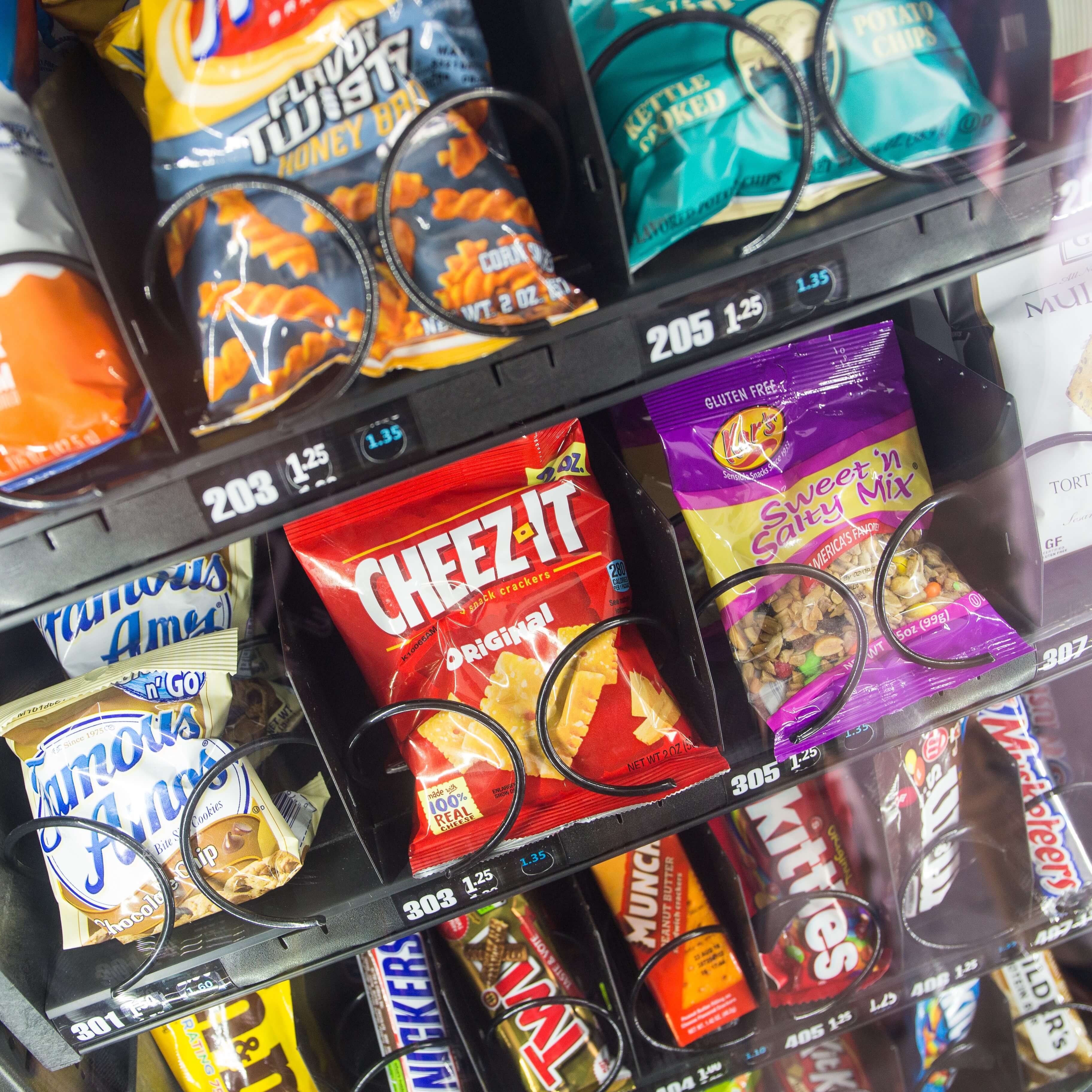
by Samantha Kennedy | Jan 26, 2018

Convenient prepackaged snacks such as these can add extra salt, fat, and sugar to your diet. (Photo credit: Lyon Duong, UF/IFAS)
Snacks are an important part of a healthy, balanced diet. But not all snacks are created equal. All too often, we reach for the salty, sugary, prepackaged snacks like chips, cookies, and other sweets because they’re convenient and easy to grab and go. But be careful! Even if the portion size is small, these types of snacks can contain a lot of unnecessary calories. Even snacks marketed as healthy, such as trail mix, granola bars, and protein bars can contain added sugars and fats.
The Nutrition Facts label contains a wealth of information…if you know what you’re looking for. The number of total calories and calories from fat are listed at the top of the label. Ideally, snacks should contain less than 200 calories. Also, if the number of calories from fat is greater than 30 percent of the total calories, it may not be the best choice.
One of the biggest pitfalls when it comes to snacking is overeating. Snacks are meant to provide sustained energy to help keep blood sugar levels even throughout the day and to supplement calories and nutrients not provided by meals. They are not meant to be mini meals, so be careful of portion size. Check the label for what constitutes one serving and stick to it.
Prepare your own snacks instead of buying prepackaged convenience foods. Cut up fruits and vegetables and store them in snack bags that can be easily toted in your purse or bag. Keep small containers of nuts – preferably unsalted or lightly salted – in your desk or car for a high-protein on-the-go snack.
There are plenty of easy, delicious, and healthy snack choices from each food group. Here are a few examples:
Fruits: Bananas, melon chunks, apple slices, and orange wedges
Vegetables: Broccoli florets, carrot sticks, sugar snap peas, and zucchini sticks
Grains: Mini rice cakes, whole grain crackers, plain popcorn, and unsalted pretzels
Proteins: Nuts (e.g. walnuts, almonds, and pistachios), hard-boiled eggs, peanut butter, and pumpkin seeds
Dairy: Low-fat yogurt, string cheese, milk, and cottage cheese
Need more help with snacking healthy? Here are some terrific resources from the University of Florida IFAS:
“Healthy Eating: Sixteen Savory Snacks” – https://edis.ifas.ufl.edu/pdffiles/FY/FY70500.pdf
“Healthy Eating: Smart Snacking” – http://edis.ifas.ufl.edu/pdffiles/FY/FY70800.pdf
“Healthy Snacking” – http://edis.ifas.ufl.edu/pdffiles/FM/FM43900.pdf
“Raising Healthy Children: Promoting a Positive Feeding Experience” – http://edis.ifas.ufl.edu/pdffiles/FY/FY139700.pdf
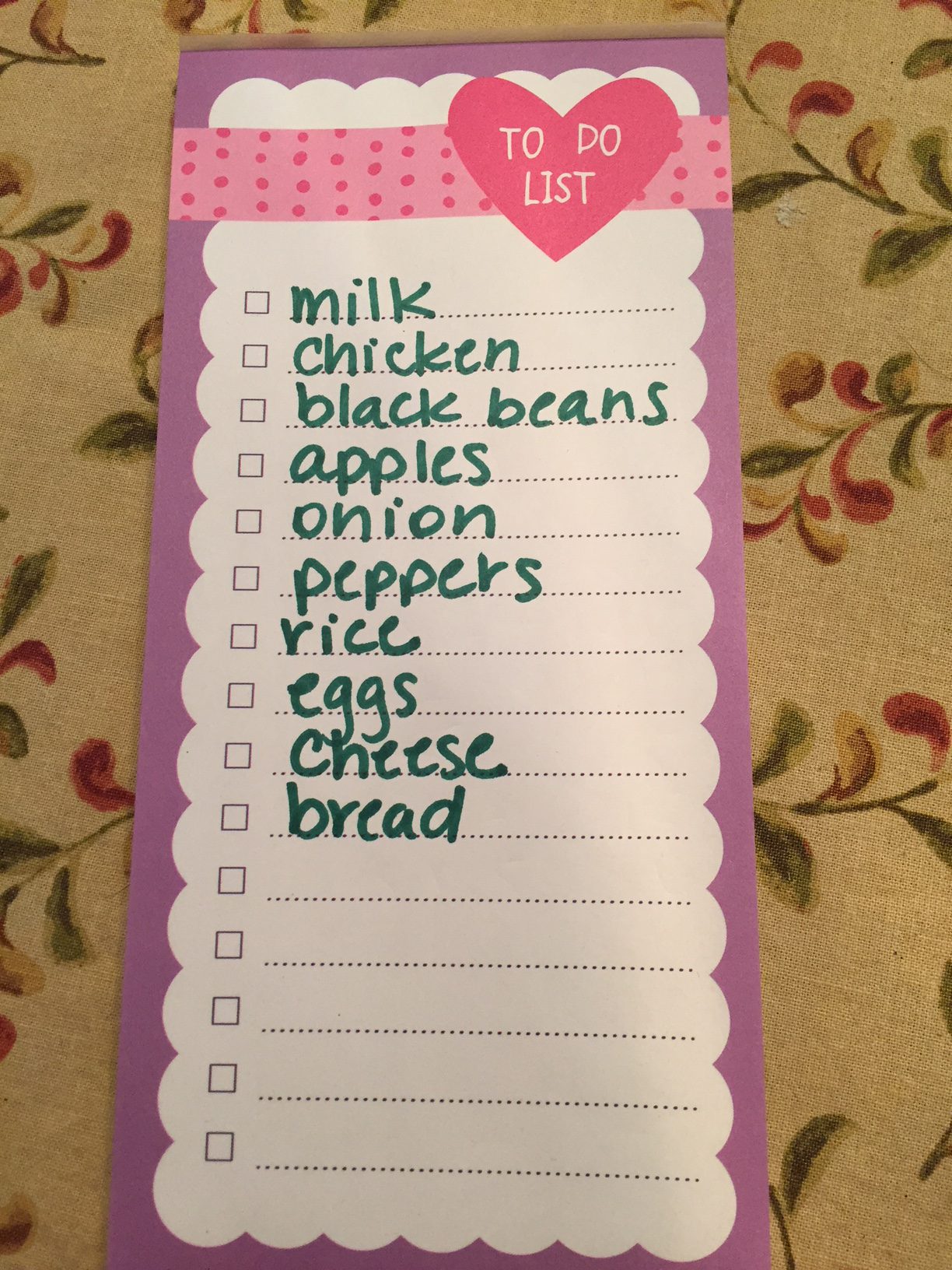
by Kendra Hughson | Jan 19, 2018
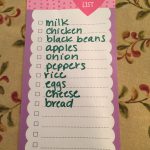
Create a shopping list using a weekly meal plan and what you already have on hand. Photo credit: Kendra Zamojski
Grocery shopping is probably one of my least favorite weekly chores. I have a family of picky eaters and it’s difficult to find healthy meals that please everyone. I can think of a million ways I’d rather spend my time than navigating the aisles of a crowded grocery store and standing in a long check-out line surrounded by countless “closed” registers. Why aren’t there ever enough open check-out lines?
I must not be alone. I hear more and more friends choosing stores with curbside pick-up service or online grocery shopping services. Many of the major grocery store chains are testing curbside pick-up service; you’ll need to check with your local store to see if this option is available in your area. Online delivery services like Shipt and Instacart may be available if curbside service isn’t an option at your local grocery store.
If you choose to do your grocery shopping online, be sure to shop around and pay attention to and compare item prices, delivery or pick up fees, membership fees, shopper or delivery tips, and other convenience fees. Regardless of your selected service, there is an extra cost for this convenience.
No matter how you choose to buy your groceries, all of the old rules apply:
Plan your weekly meals. Write some weekly meal plans with your schedule in mind. Choose some meals using recipes that are quick and easy to prepare for busy days. Use the USDA Game Plan to help you.
Find easy to prepare, healthy recipes. Use the USDA What’s Cooking website to find healthy recipes.
Know your food budget. Planning and cooking meals at home saves money over eating out. Meals prepared at home often are healthier, especially if you are preparing recipes low in fat and sodium. Track your food dollars to see how much you are spending and saving.
Plan to use leftovers. Make double batches of soups and stews, setting aside some to freeze for later use. Freeze leftovers in single portions to use for lunch or your own ready-to-eat freezer meals throughout the week.
Pack your meals with fruits and vegetables. Plan ahead to make half of your plate fruits and vegetables. Buy fresh fruits and vegetables in season. Buying canned and frozen fruits and vegetables can save money but watch for added fat, sugar, or sodium. Bananas, carrots, greens, potatoes, and apples are low-cost options year ’round.
Create your shopping list – and stick to it! Use your meal plan to create a shopping list. Remember to check what you already have on hand. Avoid impulse items and convenience items, which can add to your food costs. A list helps you organize the items you need to buy and helps you avoid impulse buys or unneeded items that can add to your food costs.
For more information on creating healthy meals, contact your local Extension office. UF/IFAS Extension also has this great publication on Healthy Meal Plans.
by Angela Hinkle | Nov 20, 2017

Dine In Day, December 3rd, is a day to set aside and share a nutritious meal with family, friends, and colleagues and have good conversation. Dining In at home together really does make a difference in the lives of our families – biological or otherwise. Sharing a meal is so fundamental to the human experience that sometimes we take this simple task for granted. Dining In at home together decreases our families’ chance of being overweight or obese. It improves our families’ relationships. We save money and eat healthier when Dining In.
Not enough time, busy schedules, and too much stress, however, might make this seemingly impossible for many families.
So here are some tips that might make Dining In a little easier for you and your family from AAFCS (American Association of Family & Consumer Sciences).
- Make family meals a priority and agree upon a schedule.
- Try to have regular family meals two to three times per week.
- If dinnertime doesn’t work, have family breakfasts or snacks.
- Keep meals simple. Slow cookers save time in the evening!
- Double recipes and freeze food for a second meal.
- Set aside 30 minutes on the weekend for meal planning.
- Make family meals fun and include children in food preparation. How about having breakfast for dinner?
- Discuss neutral or positive topics at the table. Stumped for what to talk about? Try this conversation starter: “What fun thing did you do today?”
- Eliminate distractions like TV and cell phones.
- Eat slowly and enjoy your time as a family!
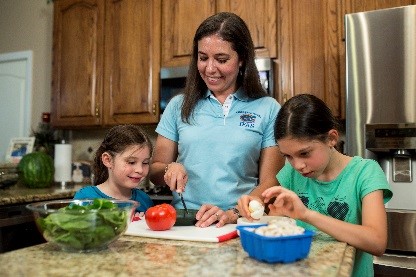
Dine In with Family
To help you make the pledge to Dine In with your family December 3rd, go to http://www.aafcs.org/fcsday/commit-to-dining-in/fcs-day-sign-up and make your very easy commitment today. After that, see how many more Dine In days you can make with your family.
To learn more about the Benefits of Family Meals, read http://edis.ifas.ufl.edu/pdffiles/FY/FY136200.pdf
by Pam Allen | Nov 18, 2017
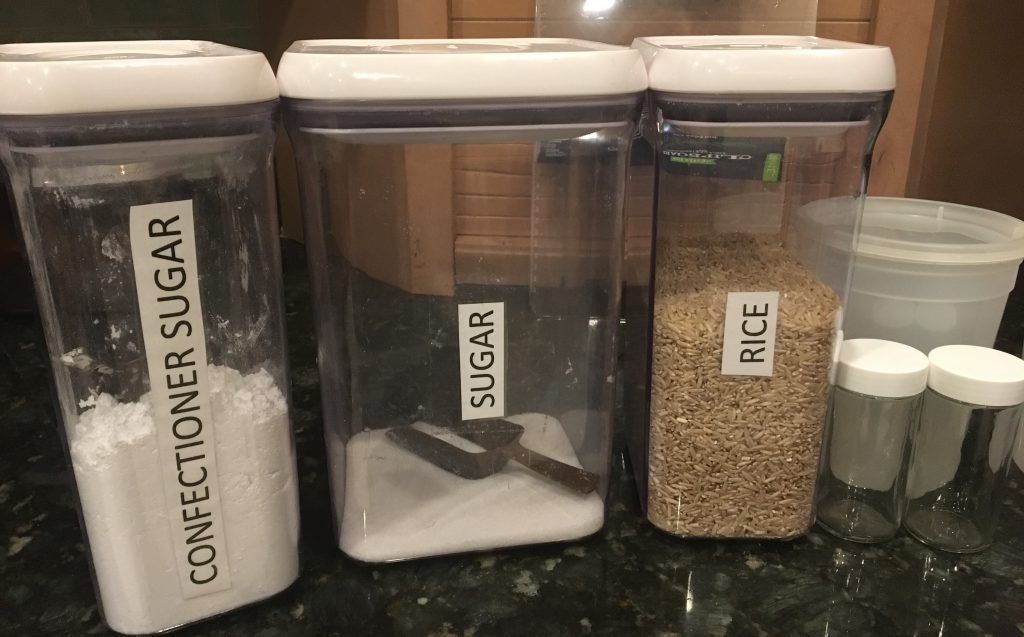
Pantry Staples
Photo credit: Pamela Allen
With fall around the corner and school starting back, it is time to take inventory of your pantry. You should really dig in and see what is lurking in the dark reaches of your back shelves. This task should be done on a regular basis to help keep foods rotated and use products that are close to expiration. It is also a good idea to refresh items that are low and you use often. Many times we are caught in the middle of preparing our favorite dish and find we are out of an ingredient. By planning and taking stock of what is in your pantry, it will be easier to plan quick and easy meals and hopefully avoid that trip to a fast food establishment to pick up something quick.
Having basic supplies on hand will keep you prepared to put together a family-friendly meal or a last-minute dinner for friends. Try to write down 4 or 5 favorites that your family likes and then keep these items on hand by keeping an inventory of your most used items. A well-stocked and organized pantry will streamline menu planning and save time on your daily food preparation. Your family will thank you for making this easy to use and find items that they most often like to eat. Here are some tips to get started:
- Decide where you will house your pantry. It can be a designated cabinet, standalone structure or a built-in pantry. The idea is to define where you will keep these supplies for easy access and organization.
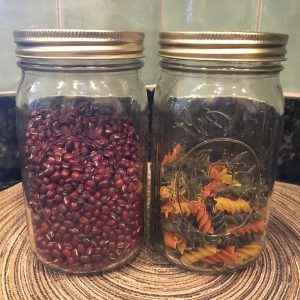
Pantry – use containers you have on hand.
Photo credit: Pamela Allen
- Inventory what you currently have and use these items first. There are many good inventory ideas you can find online. Keep a clipboard handy with your inventory list so that you can quickly see what you have on hand and what you need to add to the grocery list. Look for sales that are cost saving to stretch your food budget. Many local stores are advertising BOGOs (buy one get one) so capitalize on these items as they are on sale.
- Menu planning should be a weekly task to save time and money at the grocery store. As you plan out a weeks’ worth of meals, make a shopping list you have checked against items you have on hand. Meal planning should be centered around seasonal availability and the preferences of your family.
- Use storage containers that you have on hand. Glass containers like canning jars make great storage units for staples. The glass also allows you to see what is in the jars quickly. Remember to label items with stickers and in some cases you may need to put the purchased date.
Whatever you decide to toss in your shopping cart, you can rest happy knowing you won’t ever again have to call spaghetti with butter dinner — unless that’s exactly what you’re in the mood for.
This Healthy Eating Food Storage Guide can assist you http://edis.ifas.ufl.edu/pdffiles/FY/FY69900.pdf
Pantry items are considered dry goods or staples, things you always have on hand. Ideally, they will keep for a long time in storage, or are fresh, perishable foods regularly used up before they spoil. The idea is to subvert the need to go grocery shopping every time you cook — a major hurdle when getting food on the table.
You don’t have to buy everything at once; just buy what you think you’ll eat fairly often, and in small quantities so foods stay fresh. Build up your pantry gradually. Of course, not all ingredients work as pantry staples — fresh fruits, vegetables, meats, and other foods are perishable.
by Pam Allen | Nov 18, 2017
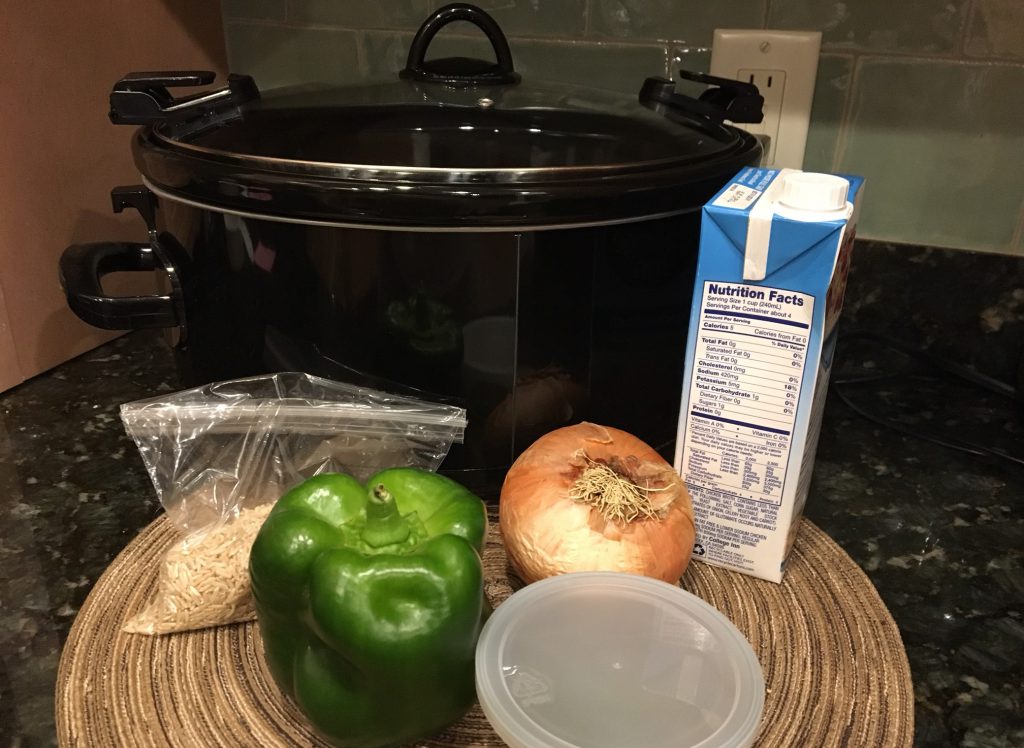
Slow Cooking
Photo credit: Pamela Allen
With the weather changing and cooler temperatures on the way, get out the slow cooker for simmering soups and stews that will be waiting for you when you get home. Slow cookers are popular and allow us the convenience of prepping ahead of time and having a hot cooked dish when we get home from a long day of work. The advantage of slow cooking is to set it and then forget it. Stirring is not usually required and remember to keep the lid on as the food simmers. Today’s slow cookers are food safe and keep food at a safe temperature of 170˚F to 280˚F. The low heat allows use of less expensive and leaner cuts of meat as the slow cooking will tenderize and shrink less.
Cooking with a slow cooker means planning ahead but the payoff is a great meal. You can prepare all the ingredients the night before like chopping of vegetables, cutting up the meat and gathering the other items and have them handy for the next morning. Remember to refrigerate all items needing refrigerating until it is time to place in the slow cooker.
Here are some tips or using your slow cooker safely and economically.
- Start with a clean cooker and utensils. Always use a clean work area and make sure to wash your hands during the preparation.
- Keep perishables refrigerated until ready to use. Store meat and vegetables separately if preparing ahead of time.
- Always thaw meat or poultry before putting it into a slow cooker. If frozen pieces are used, they will not reach 140° quick enough and could possibly result in a foodborne illness.
- Keep in mind to not lift the lid unnecessarily during the cooking cycle. Each time the lid is raised, the internal temperature drops 10 to 15 degrees and the cooking process is slowed by 30 minutes.
- After enjoying your meal, do not leave cooked food to cool down in the cooker. Store leftovers in shallow containers and refrigerate immediately.
- Do not overload the slow cooker. Fill to a minimum of 1/2 full and a maximum of 2/3 full.
Try some of these favorite recipes to get you started:
Hamburger Soup
2 pounds lean ground beef, browned and drained
2 teaspoons dried basil
2 teaspoons dried oregano
2 teaspoons garlic powder
5-6 cups tomato juice
1 cup stewed tomatoes
1 large onion, chopped
2 cups chopped celery
1 cup sliced carrots
2 cups sliced green beans, fresh or frozen
1 tablespoon Worcestershire sauce
salt & pepper to taste
Place browned meat in slow cooker. Add all remaining ingredients and stir to mix well. Cover and cook on LOW for at least 5 hours. Makes 6 servings.
Old-Fashioned Chicken & Rice
2½ cups chicken broth
1½ pounds boneless, skinless chicken breast meat, cut into 1-inch pieces or strips
1½ cups long grain rice, uncooked
¼ cup fresh parsley, minced or
1 tablespoon dried parsley
1 cup chopped onion
6 garlic cloves, minced
1 small red bell pepper, cut into thin strips
1 (6-ounce) jar sliced mushrooms, undrained
¼ teaspoon poultry seasoning
Combine all ingredients in slow cooker. Cover and cook on HIGH for 3-4 hours, or until chicken is no longer pink and rice is plumped tender.
Favorite Beef Stew
3 carrots, sliced
3 potatoes, cut in 1-inch cubes
2 pounds beef stew meat, cut in 1-inch cubes
1 cup beef broth
1 teaspoon Worcestershire sauce
1 clove garlic, minced
1 bay leaf
salt to taste
Combine all ingredients in slow cooker in order listed. Stir just enough to mix seasonings throughout. Cover and cook on LOW for 10-12 hours, or on HIGH for 5-6 hours. Makes 6-8 servings.

by Angela Hinkle | Oct 27, 2017

Peanut Butter Challenge Champion
Picture credit: Angela Hinkle
So you say you never win anything? Taking the Peanut Butter Challenge is a competition you’re guaranteed to win.
You can help feed the hungry in Florida’s Panhandle this year by donating peanut butter during the annual Peanut Butter Challenge, coordinated by UF/IFAS Extension. Thanks to a partnership between UF/IFAS Extension and the Florida Peanut Producers Association, food pantries from Pensacola to Monticello will receive thousands of jars of donated peanut butter this December.
From October 1 through November 22, you can donate unopened jars of peanut butter at your UF/IFAS Extension county office. Since 2012, UF/IFAS Extension faculty and volunteers have collected jars of peanut butter from residents, volunteer groups, and businesses in 16 northwest Florida counties. Last year, UF/IFAS Extension county offices received 3,236 jars of peanut butter! In addition to these donations, the Florida Peanut Produces Association also contributes, supplying more than 3,000 jars each year to the Challenge.
We hope to surpass last year’s total! This year, citizens throughout the Florida Panhandle counties are asked to help by donating peanut butter and becoming Peanut Butter Challenge Champions.
“The Peanut Butter Challenge not only raises awareness about the important contribution of North Florida’s peanut growers to the state peanut industry, but also helps provide a healthy, locally produced product to food-insecure families in northwest Florida,” said Libbie Johnson, Agricultural Agent in Escambia County.
Why peanut butter? Peanut butter is the most requested item at food pantries. See https://youtu.be/fPFvSgzmM3Y to learn more. A serving of peanut butter is loaded with protein, vitamins, minerals, fiber, and “good” fats. Peanut butter is a shelf-stable item – meaning it does not have to be heated or refrigerated. And people really like the taste.
How do you become a Peanut Butter Challenge Champion? Look for peanut butter BOGOs and other discounted sales at your local stores. Keep a jar for yourself and give the other unopened jar(s) to the Peanut Butter Challenge.
Voila! Everyone’s a winner! And you may proudly say, “I am a Peanut Butter Challenge Champion!”











